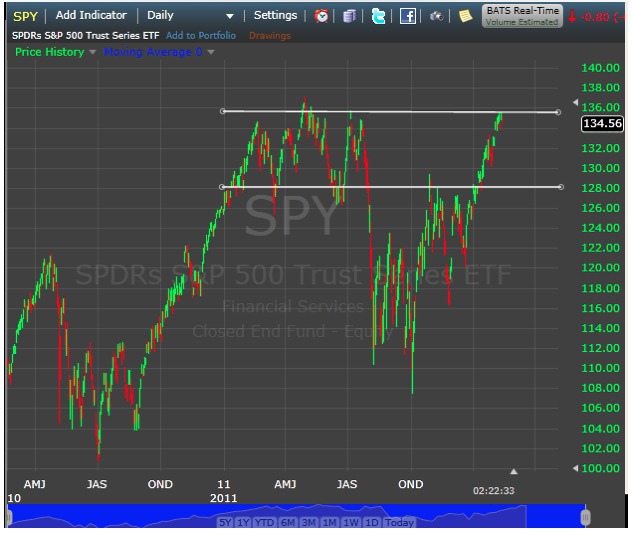 Author: Bill DeShurko, 401 Advisor
Author: Bill DeShurko, 401 Advisor
Covestor model: Dividend and Income Plus
Disclosure: Long PSP
One mistake many investors make is to view their portfolio in a vacuum. While many strategies are designed to minimize market influences, the truth is that the markets have become extraordinarily correlated since the financial crisis. So when reviewing performance and strategy for my Dividend and Income Plus portfolio, I always look at what is happening to the overall market.
Below is a chart of the SPDR S&P 500 ETF Trust (SPY) The horizontal white lines show the trading range the market was in for the first half of 2011. After the summer 2011 selloff and subsequent rally, the market re-entered the trading range around the first of this year. It was clear at that point that regardless of where the market went, the media would make the next move out to be the beginning of either the next great bull market, or the return of the secular bear.
Either way the market went, it was fairly meaningless as far as predicting the longer-term trend. Instead, having entered back into an established trading range, the markets were more likely to test the range’s resistance around 136 and support around 128. Any bouncing around between these levels would just be the market consolidating its rally, prior to the next move.
What would be important would be any breakout above or below these levels.
Sticking with this thesis, I decided to review account holdings over the last couple weeks as the market continued its climb toward that upper resistance level. If I’m right, the market should head lower, toward support, for the rest of February.
First, a word on my “predictions.” One thing that continually surprises me is how poorly most people understand the concept of probabilities. A probability is an indication of something that might happen. That is very different from a certainty. However, if we can assign some type of weighting to probabilities they can become very valuable – ask a Vegas sports bookie about spreads and odds.
In this case, there is no certainty that the market is in the process of peaking (temporarily?), but it is a common occurrence, and we have some pretty strong areas of support and resistance that were established over a six-month period in 2011. My point is, I’m not betting the ranch here, and I’m certainly not going to make any extreme bets with client money. But after a nice run this year, and a really nice run from last year’s market bottom, it is a good time to review holdings and see if our portfolios can benefit from some upgrading. The charts just help with timing the trade.
For my Covestor portfolio I decided it was time to cut ties with MV Oil Trust (MVO). While I like its dividend, I get worried about laggards during market rallies.
I also chose to sell another holding, Prospect Capital (PSEC). While PSEC has performed well and pays a very nice dividend, I decided that I felt more comfortable holding PowerShares’ Global Private Equity ETF (PSP) . Longer term, PSEC and PSP have similar returns, but with the market potentially getting a little stretched, I like the diversity of the ETF vs. an individual holding. (More on the “buy” side in a later post.)
When I looked at the chart for SPY above, I decided I would do the sells, but hold off on the subsequent buys. If I’m right and the market consolidates and heads down to its prior resistance level, I will have made a good choice and can buy my new holdings at a better price. If I’m wrong, all I give up is a little upside as the market breaks through resistance. If the fundamentals are strong, I can look to buy around the 138 level. If the market breaks out to the upside and I don’t get back in until later, I could be giving up some potential gain. But I also have raised extra cash for my portfolio if the market drops to the support level around 128.
Overall, I am still bullish and would prefer being 100% long. But when planning portfolio changes, it can make sense to observe the overall market, make your assumptions, and act accordingly. In this case I just can’t see making a buy decision when it looks to me like we are approaching a pretty strong resistance level. And fundamentally – with falling corporate earnings and continued troubles in Europe – I see far more compelling the arguments for the market to temporarily pause than for it to power through to new highs.




